All the things you love about Filipino pork humba are in this recipe. Meltingly tender pork belly slowly cooked in an adobo-like sauce that is rich, sweet, salty, glossy, and tangy.
This Filipino dish is characterized by the spices derived from Chinese braised pork belly–banana blossoms, star anise, and salted black beans. It is truly one of the best Filipino-Chinese food fusion you’ll ever have.
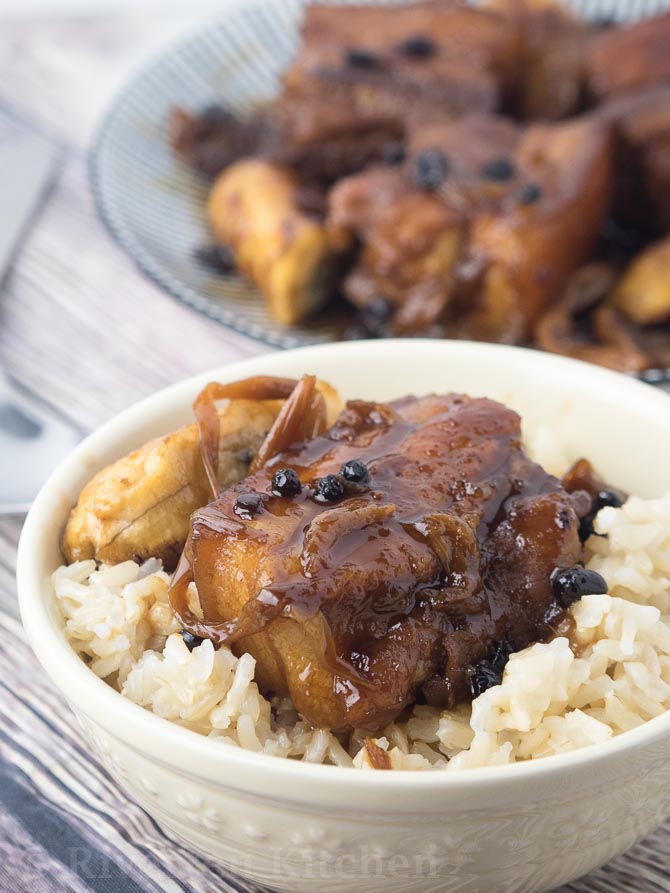
What is Filipino Humba?
Pork Humba is a cross between Chinese braised pork belly and Filipino adobo. A food fusion that has wonderfully evolved through time.
Humba and adobo both use vinegar and soy sauce as the base for the sauce. Humba is sweeter with the addition of brown sugar yet it uses all the spices that are in adobo–lots of garlic, onions, whole black pepper, and bay leaf.
What differentiates Humba from adobo are the spices derived from Chinese braised pork belly and its different variations–banana blossoms (probably known as a dried lily flower, I’m confused too), star anise, and tausi (salted black beans).
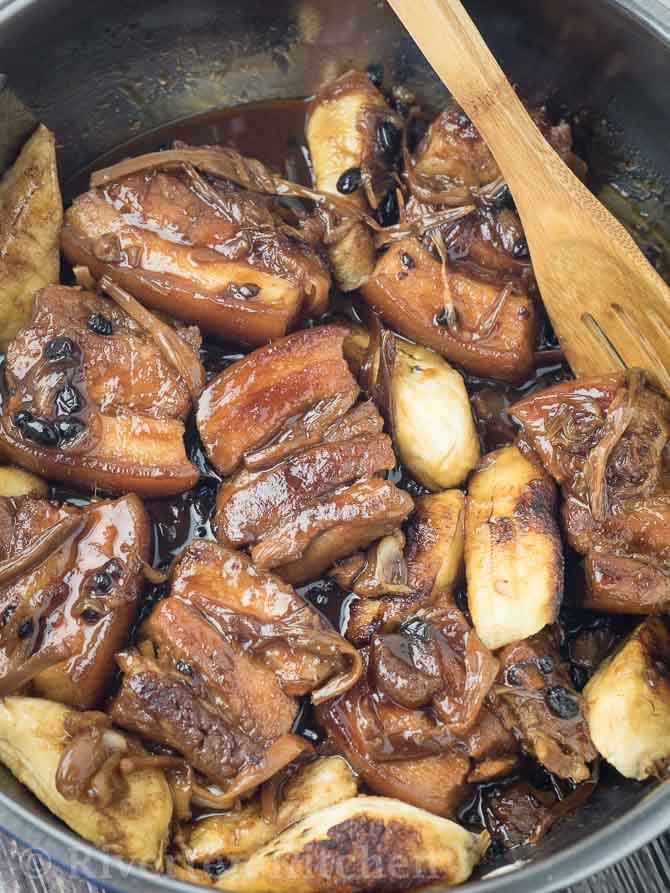
What is the best part of pork for humba?
Pork Belly is the best pork cut for humba. It has the perfect (often not so) balance of fat and meat. Substituting it with leaner parts of the pork might be unwise. Humba wouldn’t be “humba” without the soft gelatinous pork fat. Agree?
The next best part would probably be pork hock (pata ng baboy) or pork knuckle. It’s tougher than the pork belly thus requires a longer cooking time.
Sweet Pork Humba
Traditional humba recipes use muscovado which is unrefined sugar with high molasses content. It is often substituted with brown sugar as it is typically available in many supermarkets and grocery stores.
Pineapple Juice is the complementary sweetener of this pork humba recipe. It is actually my Mama’s (a Visayan through and through) secret ingredient that she so willingly shared with me. And I love, love, love the sweet and tangy flavor it gives to the dish.
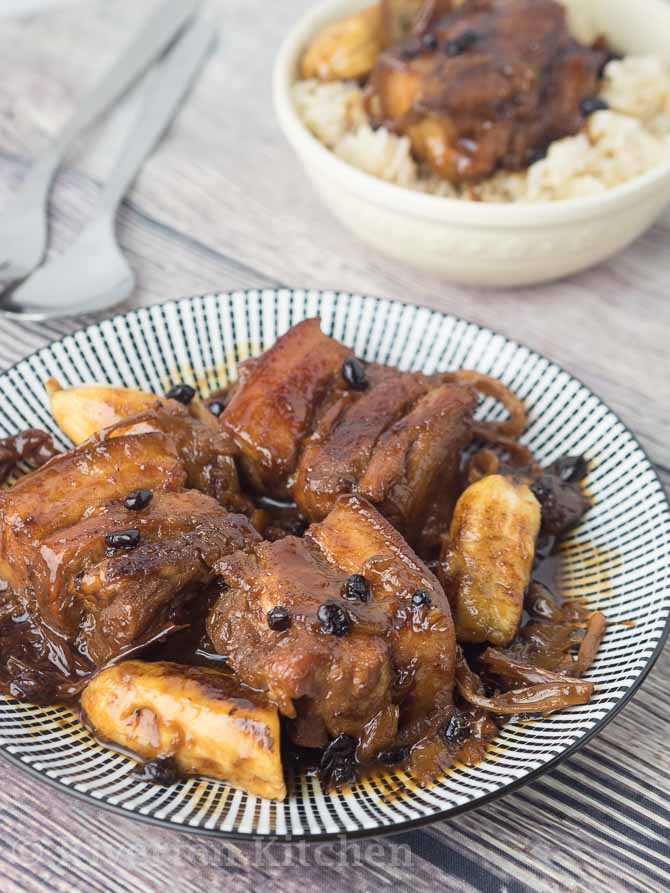
How to make Meltingly Tender Pork Humba
- Sear the pork belly in batches. Overcrowding the pan, prohibits good browning.
- Use a pot with a snug fit lid. It should have high sides so it can hold enough liquid to surround the meat. Place the lid on while braising to prevent the liquid from evaporating.
- Use medium heat to make a rich and deeply flavored sauce. Using high-heat can cause the meat to burn and the liquid to disperse quickly without tenderizing the pork.
- Use enough liquid but don’t totally submerge the pork. Add water as necessary and keep cooking until pork is meltingly tender.
The best humba sauce: Tips!
- Blanch the pork in boiling water to remove the scum. Rinse with tap water to remove any scum that may have stuck to it. This step helps make a clearer and shiny humba sauce. It can also help remove any unpleasant odor of the pork (if there’s any).
- If you have the time, sear the pork without oil and let the fat render naturally. This takes time so I often do the shortcut of frying it in hot oil and just scoop out the excess oil.
- To infuse the flavor of the sauce, simmer the pork for a few minutes in the sauce mixture before adding the water. Cover with lid. Once it starts boiling, set the heat to medium-low and slowly braise until pork is meltingly tender. Remember to stir occasionally.
- If the liquid reduces too quickly (caused by different factors e.g. heat too high, pot too wide, etc), just keep on adding water about 1/2 cup at a time. Don’t worry it will evaporate eventually.
- Remember the sauce gets saltier as the sauce reduces i.e. water evaporates. Do a taste test before adding more salt or soy sauce BEFORE your humba finishes cooking.
How long is the cooking time?
Cooking time largely depends on the size and thickness of the pork. Small pieces could take 45 minutes to 1 hour while large chunks could take 1 1/2 to 2 hours. Mine was done at about 1 hour and 45 minutes then reduced the sauce for about 10 minutes at medium-high heat.
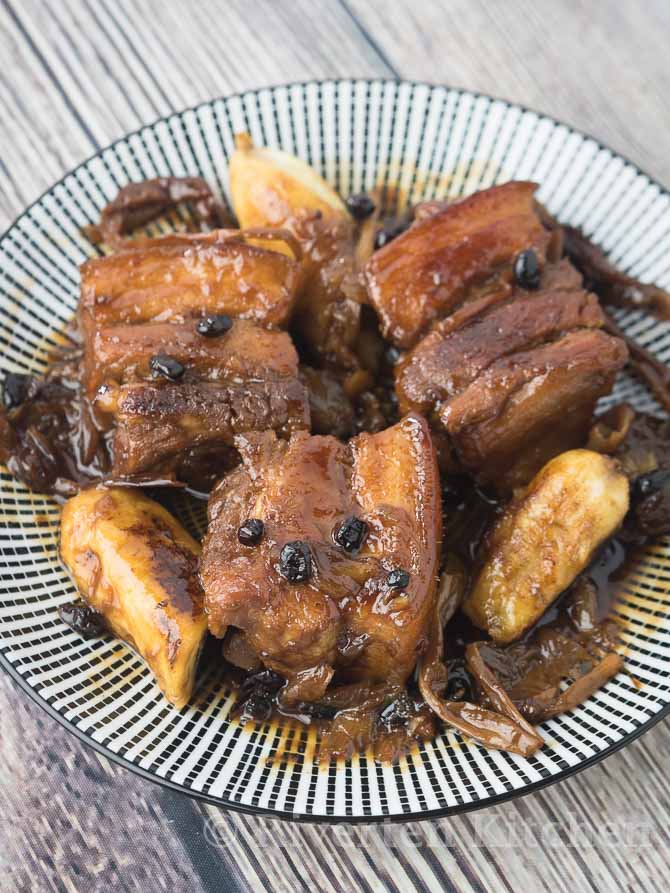
My favorite humba toppings/ add-ins
I love adding fried bananas and hard-boiled eggs to my pork humba. They not only extend the dish but also makes it extra special. Perfect for any Filipino party and special occasions.
And just like many Filipino dishes, Pork humba is best served with rice and is always better the next day. Enjoy!
More Filipino Pork Recipes
- Pineapple Cured Pork Tocino
- Sinigang na Baboy (Pork Sinigang)
- Pork Ribs Adobo Pressure Cooker Recipe
- Easy Pork Belly Sisig
- Pork Menudo (Filipino Pork and Liver Stew)
- Embutido
- Pork Igado
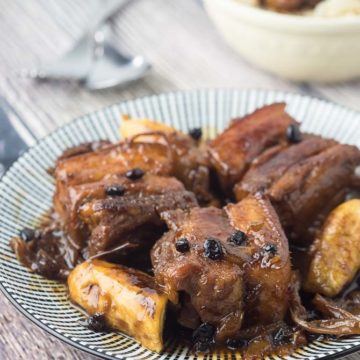
Filipino Pork Humba
Ingredients
- 1 kg /2 lbs pork belly
- 2 cups water (for boiling, to be discarded)
- 2 tsp vegetable oil (I used canola)
- ⅓ cup Filipino soy sauce (see note 2)
- 1 cup canned pineapple juice
- 3 tbsp rice vinegar
- 1 whole garlic (peeled, cloves separated)
- 8 pcs shallots (peeled)
- 2 cup hot water (add more if needed)
- 1-2 star anise (make it two if preferred)
- 3 tbsp salted black beans /tausi (washed and drained)
- ½ cup dried banana blossoms
- 1 tsp whole black pepper
- 2 tbsp brown sugar (packed, add more if preferred)
- fried saba bananas (optional)
Instructions
- Place pork belly in a large pot. Add 2 cups of water and boil for 5 minutes over high heat. Discard water. Wash pork belly with running tap water to remove the scum. Slice into big chunks or your preferred size.
- Heat 1 tbsp of oil in the same pot over medium-high heat. Add the pork belly and cook for 1 minute on each side — they should begin to brown and release some fat into the pot. Set aside.
- Lower the heat to medium. Add shallots and garlic. Saute until softened. Cover with a lid if needed but watch carefully so it doesn't burn.
- Add back the pork. Pour soy sauce, vinegar, pineapple juice, whole black pepper, brown sugar. Let it simmer for 2 minutes.
- Add water and star anise. Cover with a lid. Cook until tender (See note 1 for cooking times). Stir occasionally.
- Remove the lid 15 minutes before it finishes cooking to reduce and thicken the sauce. Add star anise, black beans, and banana blossom. Taste. Adjust soy sauce, sugar as necessary. Cook until sauce is reduced to desired thickness. Serve over rice and enjoy!
Recipe Notes & Tips:
- Cooking time: small pieces could take 45 minutes to 1 hour while large chunks could take 1 1/2 to 2 hours. Mine was done at about 1 hour and 45 minutes then reduced the sauce for about 10 minutes at medium-high heat.
- Soy sauce: Use Filipino soy sauce to get that authentic adobo flavor. It can be substituted with any regular soy sauce but you will need to experiment with the amount because the saltiness may vary.
- Vinegar: white rice vinegar (not seasoned), cane vinegar, coconut vinegar, and apple cider vinegar are good options.
- Use pure pineapple juice from the can, not syrup.
- Dried banana blossoms: After a few google searches, I found out that this could actually be the same with dried lily flowers. I will update this post once I get my hands on the lily flowers and compare it with the banana blossoms I have.


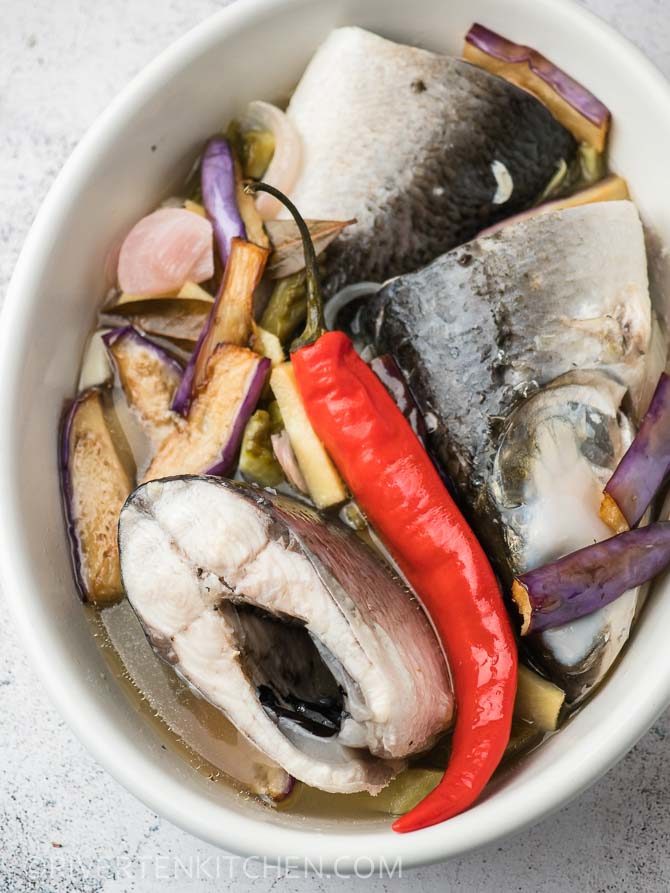
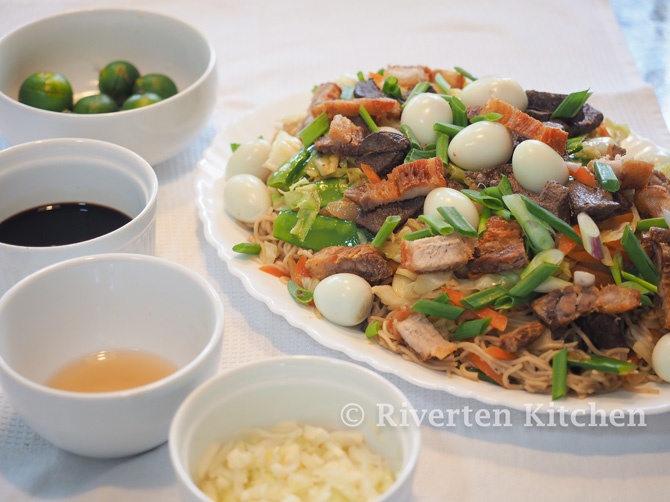
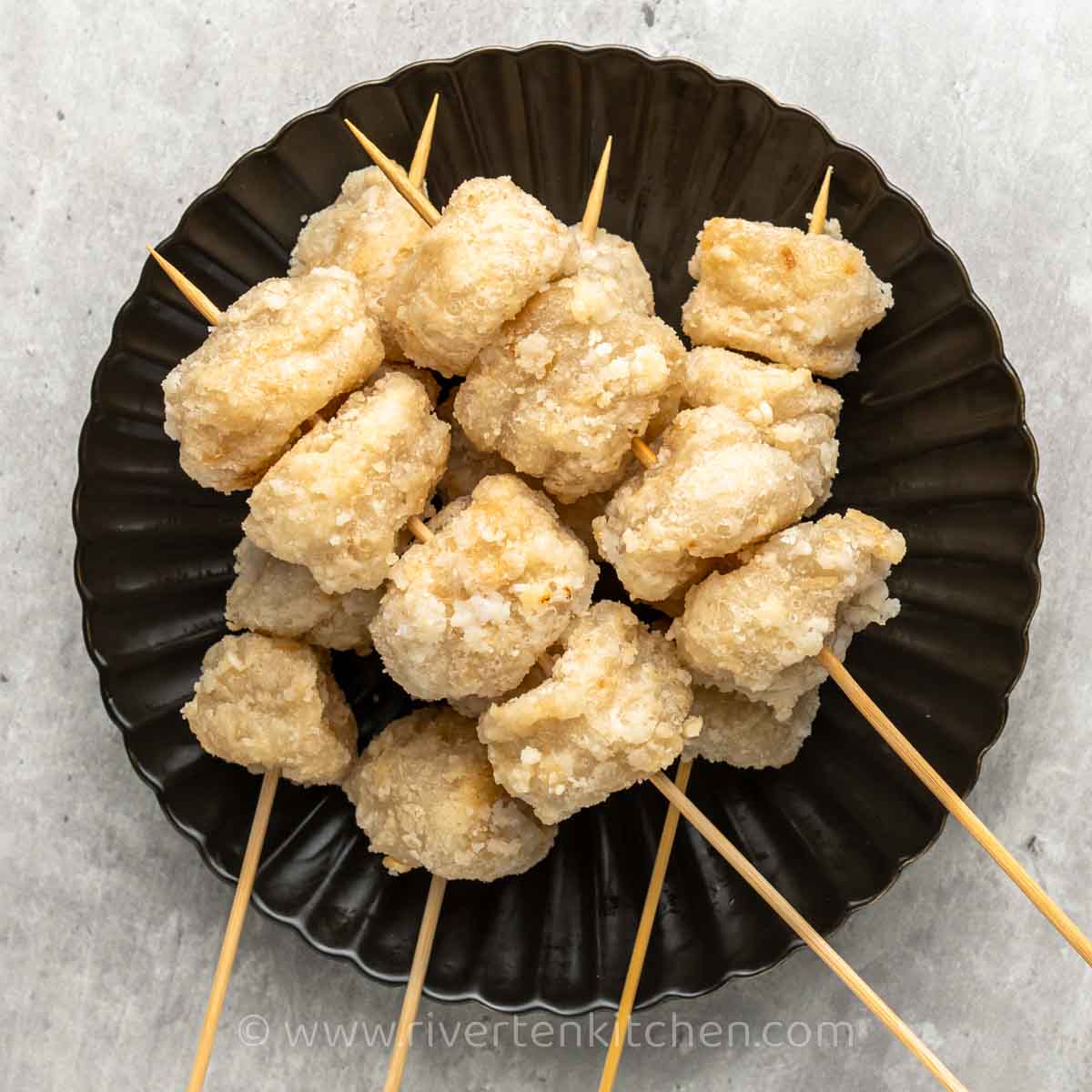
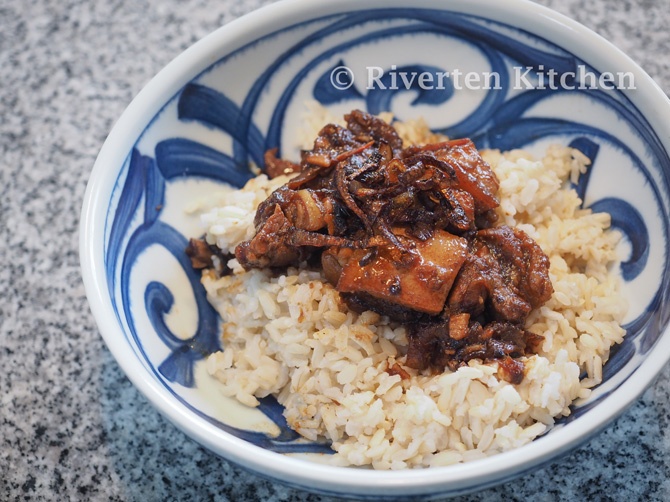
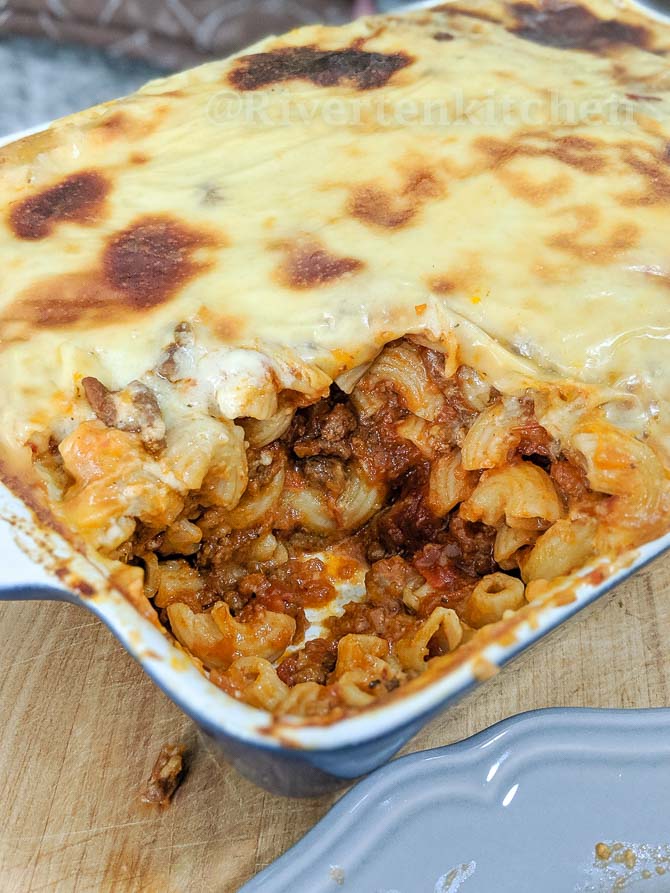
Is it ok to use, shiitake mushrooms? I don’t have banana blossoms
Perfectly fine 🙂 My grandfather loves using shitake mushrooms over banana blossoms.
-Mella
Yummy! Being a Filipina, I’d say this is the best recipe I’ve tried so far. It really melts in your mouth. I washed the banana blossoms concerned that it would be too salty; I shouldn’t have because the recipe is perfect as it is. I just wasn’t sure how many star anise to put so I put 3. It wasn’t as noticeable for me but my Spanish sis-in-law did notice it eating it the day after. My in-laws loved it that one of them asked for the recipe. Thank you so very much!! Kudos!!!
You’re welcome, Cheryl! I’m so happy to hear you and your family enjoyed this recipe. I’ve updated the recipe card, re: star anise. Sorry about that.
– Mella
Oh, no worries, Mella. I think you meant just one. Just felt like I needed more. Anyhow, thanks for modifying the recipe. Really sumptuous. Even though I used apple cider vinegar and platano de canarias, it still tasted wonderful. I suggest to those who’d like to try though, to add the fried bananas just after cooking, as my bananas completely vanished into thin air.
It’s not really my thing to rate a recipe but you made me do it. ? Thanks again, Mella!
Hi is this ok without the banana blossoms?
Yes! It should be fine